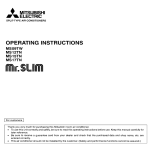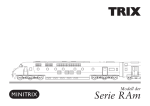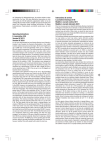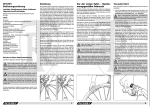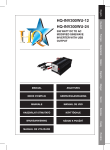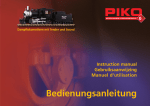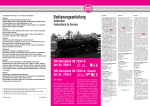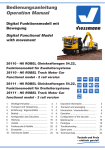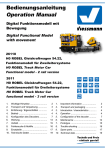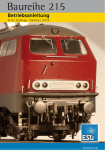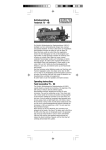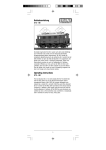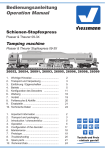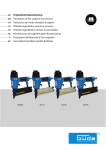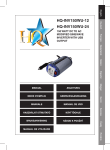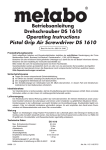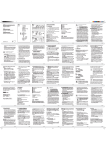Download MT 12549 BR 44 Soundlok
Transcript
Modell der BR 44 12549 Informationen zum Vorbild Für den Mitte der 20er Jahre nötigen Bau von schweren 5-fach gekuppelten Güterzuglokomotiven mit 20 t Achslast war noch nicht entschieden, ob die Lokomotiven als 2- oder 3-Zylinder-Maschinen gebaut werden sollten. Zu Vergleichszwecken wurden je 10 Prototypen als 2-zylindrige BR 43 sowie 3-zylindrige BR 44 gebaut. Dabei zeigte sich bei der BR 43 ein geringfügig geringerer Dampfverbrauch, weshalb diese vorerst mit weiteren 25 Loks weitergebaut wurde. Information about the prototype In the mid-1920s there was a need to build heavy freight locomotives with 5 coupled axles and a 20 metric ton axle load. No decision had been reached regarding whether these locomotives were to be built as 2 or 3cylinder locomotives. Ten prototypes of each were built for comparison tests as the 2-cylinder class 43 and the 3-cylinder class 44. The tests showed that the class 43 had a slightly lower rate of steam consumption, and another 25 of this class were initially built. Da aber die Anforderungen an Zugkraft und höheren Geschwindigkeiten gestiegen waren, entsann man sich wieder der BR 44, die durch den besseren Massenausgleich und den geringeren Zapfendruck hierfür besser geeignet war. Since the requirements for tractive effort and higher speeds had increased, the class 44 came to mind again because it had a better weight distribution and a lower journal pressure which made it more suitable. Ab 1937 lief deshalb die überarbeitete Serienproduktion bei den Firmen Henschel, Krupp und Schwartzkopff an. Gebaut wurden insgesamt 1989 Maschinen, während und nach dem Krieg u.a. auch in Frankreich, weshalb über 200 Loks als 150 X auch dort verblieben. Bauart Länge ü. Puffer Höchstgeschwindigkeit Dienstmasse Nennleistung Baujahr der Serie ab 2 1‘E h3 22 620 mm 80 km/h 169 t 1400 kW (1910 PS) 1937 Starting in 1937 the reworked regular production locomotives were built by the firms of Henschel, Krupp, and Schwartzkopff. A total of 1,989 units were built, some of them during and after World War II in France among other places, which is why 200 locomotives remained there as the class 150 X. Design Length over buffers Maximum speed Service weight Nominal power Regular series built starting in 2-10-0 22,620 mm / 74 ft. 2-9/16 in. 80 km/h / 50 mph 169 metric tons 1400 kW (1,910 hp) 1937 Informations concernant le modèle réel Au milieu des années vingt, dans le cadre de la construction de locomotives lourdes à 5 essieux accouplés pour trains de marchandises, les responsables hésitaient encore entre des machines à 2 cylindres et à 3 cylindres. Afin de trouver une solution à ce dilemme, 10 prototypes furent construits en deux séries distinctes à titre de comparaison : la série 43 à 2 cylindres et la série 44 à 3 cylindres. La BR 43 ayant révélé une légèrement plus faible consommation de vapeur, on en construisit une première tranche de 25 exemplaires. Entre-temps, les exigences du trafic requérant toujours plus de puissance et de vitesse, on se souvint de la BR 44 dont le meilleur équilibrage des masses et la moindre pression sur les tourillons convenait davantage. C‘est ainsi que démarra à partir de 1937 la production en série de ces locomotives par les firmes Henschel, Krupp et Schwartzkopff. Au total, 1989 machines furent construites dont 200 exemplaires furent conservés par la France après la fin de la guerre et versées dans la série 150 X. Disposition d‘essieux Longueur hors tampons Vitesse maximale Poids en ordre de marche Puissance nominale Année de construction à partir de 1‘E h3 22 620 mm 80 km/h 169 t 1400 kW (1910 CV) 1937 Informatie over het voorbeeld De voor het midden van de jaren ‘20 vereiste bouw van zware 5-voudig gekoppelde goederentreinlocomotieven met 20 t aslast was nog niet beslist, of de locomotieven als 2- of 3-cilindermachines gebouwd moesten worden. Ter vergelijking werden van elk 10 prototypen als 2cilinder BR 43 en 3-cilinder BR 44 gebouwd. Daarbij liet de BR 43 een enigszins minder stoomverbruik zien, om welke reden deze voorlopig met nog eens 25 locs verder gebouwd werd. Omdat echter de eisen aan trekkracht en hogere snelheden gestegen waren, herinnerde men zich weer de BR 44, die door de betere compensatie van de massa en de geringere tapdruk hiervoor beter geschikt was. Vanaf 1937 begon daarom de gemodificeerde serieproductie bij de firma‘s Henschel, Krupp en Schwartzkopff te lopen. Er werden in totaal 1989 machines gebouwd, tijdens en na de oorlog o.a. ook in Frankrijk. Daarom verbleven daar ook meer dan 200 locs als 150 X. Type Lengte o. buffers Maximumsnelheid Dienstgewicht Nominaal vermogen Bouwjaar van de serie vanaf 1‘E h3 22 620 mm 80 km/h 169 t 1400 kW (1910 pk) 1937 3 Funktionen • Eingebaute Elektronik zum wahlweisen Betrieb mit konventionellem Gleichstrom-Fahrgerät, TRIX Selectrix oder Digitalsystemen nach NMRA-Norm (DCC). • Automatische Systemerkennung zwischen Digitalund Analog-Betrieb. • Keine automatische Systemerkennung zwischen Selectrix (SX) und DCC. • Der volle Funktionsumfang ist nur unter Selectrix 2 (SX2) und unter DCC verfügbar. • Wartungsfreier Hochleistungs-Glockenankermotor. • Dreilicht-Spitzensignal vorne, im Digitalbetrieb mit der Fahrtrichtung wechselnd • Mit Kinematik für Kurzkupplung und Kupplungsaufnahme nach NEM. • Kurzkupplung zwischen Lok und Tender. • Analog 14 Volt =, digital 22 Volt ~. Hinweise zum Digitalbetrieb: • Beim ersten Betrieb in einem Digital-System (Selectrix oder DCC) muss der Decoder auf dieses DigitalSystem eingestellt werden. Dazu ist der Decoder ein mal in diesem Digitalsystem zu programmieren. • Die genaue Vorgehensweise zum Einstellen der diversen Parameter entnehmen Sie bitte der Bedienungsanleitung Ihrer Mehrzug-Zentrale. • Die ab Werk eingestellten Werte sind so gewählt, dass ein problemloser Betrieb gewährleistet ist. • Ab Werk ist bei dieser Lok für Digitalbetrieb die Adresse „01“ (Selectrix) / „03“ (DCC) programmiert. • Ein Betrieb mit gegenpoliger Gleichspannung 4 in Bremsabschitten bei DCC-Betrieb ist mit der werkseitigen Einstellung nicht möglich. Ist diese Eigenschaft gewünscht, so muss auf den konventionellen Gleichstrom-Betrieb verzichtet werden (CV 29 / Bit 2=0). • Funktion: SX1 SX2 DCC Licht Licht Licht F0 Fahrgeräusch Funk. F1 F1 Pfeife (langer Pfiff) – F2 F2 Luftpumpe – F3 F3 Pfeife (kurzer Pfiff) – F4 F4 Kupplungsgeräusch – F5 F5 Sicherheitshinweise • Beachten Sie unbedingt die Sicherheitshinweise in der Gebrauchsanleitung zu Ihrem Betriebssystem. • Nicht für Fahrgeräte mit Impulsbreitensteuerung. • Nicht für Dauerzugbeleuchtung auf Analog-Anlagen. • Nicht für Trix ems. Jegliche Garantie-, Gewährleistungs- und Schadensersatzansprüche sind ausgeschlossen, wenn in Trix- Produkte nicht von Trix freigegebene Fremdteile eingebaut werden und/oder Trix- Produkte umgebaut werden und die eingebauten Fremdteile bzw. der Umbau für sodann aufgetretene Mängel und/oder Schäden ursächlich war. Die Darlegungs- und Beweislast dafür, dass der Einbau von Fremdteilen oder der Umbau in bzw. von Trix-Produkten für aufgetretene Mängel und/oder Schäden nicht ursächlich war, trägt die für den Ein- und/ oder Umbau verantwortliche Person und/ oder Firma bzw. der Kunde. Hinweis: Änderungen der mit * gekennzeichneten Einstellungen in der Betriebsart Selectrix führen automatisch auch zu Änderungen in der Betriebsart DCC und umgekehrt! CV Bedeutung Wert DCC ab Werk DCC / SX Wert Selectrix 1 Adresse 1 - 127 3/1 1 - 99 3 Anfahrverzögerung 0 - 127 5/5 1-7 4 Bremsverzögerung 0 - 127 5/5 1-7 1-7 6/6 1-7 CV 29, bit 5=1 255 / — nicht notwendig CV 29, bit 5=1 255 / — nicht notwendig *** 0. 1, 2, 3, 4, 5, 6, 7, 32, 34, 35, 36, 37, 38, 39 6/— nicht notwendig 5 * Maximalgeschwindigkeit 17 Erweiterte Adresse (oberer Teil) 18 Erweiterte Adresse (unterer Teil) 29 bit 0: Umpolung Fahrtrichtung bit 1: Anzahl Fahrstufen 14/28 bit 2: DCC Betrieb mit Bremsstrecke DCC-, Selectrix- und Gleichstrombetrieb bit 5: Adressumfang 7 bit / 14 bit Wert 0/1 0/2 0/4 0 / 32 49 * Impulsbreite zur Motorsteuerung 0-3 0/1 1-4 50 * Regelvariante 0-3 2/3 1-4 51 * bit 0: Motorumpolung bit 1: Umpolung Licht bit 2: Umpolung Gleis *** 0-7 4/— nicht notwendig 0/1 0/2 0/4 *** Die Werte der gewünschten Einstellungen sind zu addieren! 5 Functions • Built-in electronic circuit for oberation with an conventional DC power pack, Trix Selectrix or NMRA DCC digital. • Automatic system recognition between digital and analog operation. • No automatic system recognition between Selectrix (SX) and DCC. • The full range of functions is only available under Selectrix 2 (SX2) and under DCC. • Maintenance-free, high-efficiency can motor with bell-shaped armature. • Triple headlights at the front that change over with the direction of travel in digital operation. • NEM close coupler mechanism and coupler pocket. • Close coupling between locomotive and tender. • Analog 14 volts DC, digital 22 volts AC. Notes on digital operation: • The first time the locomotive is used in a digital system (Selectrix or DCC), the decoder must be set for this digital system. To do this, the decoder must be programmed once in this digital system. • The operating instructions for your central unit will give you exact procedures for setting the different parameters. • The values set at the factory have been selected to insure trouble-free operation. • This locomotive comes from the factory programmed for the digital address „01“ (Selectrix) / „03“ (DCC). • This locomotive with the settings made at the factory cannot be operated with opposed polarity DC power in braking track blocks. If this feature is desired, then 6 you must do without conventional DC operation (CV 29 / bit 2=0). • Function: SX1 SX2 DCC Head- HeadHeadlights F0 lights lights Operating Sounds Func. F1 F1 Whistle (long blast)) – F2 F2 Air pump – F3 F3 Whistle (short blast) – F4 F4 Coupler Sounds – F5 F5 Safety Warnings • Pay close attention to the safty warnings in the instructions for your operating system. • Not suitable for locomotive controllers with pulse width control. • Not suitable for continuous train lighting on analog layouts. • Not suitable for Trix ems. No warranty or damage claims shall be accepted in those cases where parts neither manufactured nor approved by Trix have been installed in Trix products or where Trix products have been converted in such a way that the non-Trix parts or the conversion were causal to the defects and/or damage arising. The burden of presenting evidence and the burden of proof thereof, that the installation of non-Trix parts or the conversion in or of Trix products was not causal to the defects and/or damage arising, is borne by the person and/or company responsible for the installation and/or conversion, or by the customer. Important: Changes in the settings market with ( * ) for the Selectrix mode of operation automatically lead to changes in the DCC mode of operation and versa! CV Discription DCC Value Factory Setting, DCC / SX Selectrix Value 1 address 1 - 127 3/1 1 - 99 3 acceleration delay 0 - 127 5/5 1-7 4 braking delay 0 - 127 5/5 1-7 1-7 6/6 1-7 5 * maximum speed 17 extendet address (upper part) CV 29, bit 5=1 255 / — not necessary 18 extendet address (lower part) CV 29, bit 5=1 255 / — not necessary 29 bit 0: Travel direction polarity reversal bit 1: number of speed levels 14/28 bit 2: DCC Operation with braking Block DCC-, Selectrix and DC power operation bit 5: address size 7 bit / 14 bit *** 0. 1, 2, 3, 4, 5, 6, 7, 32, 34, 35, 36, 37, 38, 39 6/— not necessary Value 0/1 0/2 0/4 0 / 32 49 * pulse width for motor control 0-3 0/1 1-4 50 * ule variant 0-3 2/3 1-4 51 * bit 0: motor polarity reversal bit 1: lighting polarity reversal bit 2: track polarity reversal *** 0-7 4/— not necessary *** The values for the desired settings must be added. 0/1 0/2 0/4 7 Fonctionnement • Electronique intégrée pour exploitation au choix avec transformateur-régulateur conventionnel délivrant du courant continu, avec Selectrix ou avec des sastèmes de vonduite digitale conformes aux normes NMRA. • Reconnaissance automatique du système entre exploitations numérique et analogique. • Pas de reconnaissance automatique entre les systèmes Selectrix (SX) et DCC. • L’intégralité des fonctions est disponible uniquement en exploitation Selectrix 2 (SX2) et DCC. • Moteur performant à rotor sans fer exempt d‘entretien. • Fanal à trois feux à l’avant, inversion en fonction du sens de marche en mode d’exploitation numérique. • Avec boîtier normalisé NEM à élongation pour attelage court. • Attelage court entre locomotive et tender. • Analogique 14 volts =, digital 22 volts ~. Remarques relatives au fonctionement en modedigital: • Une première exploitation en système numérique (Selectrix ou DCC) exige le réglage correspondant du décodeur. A cet effet, le décodeur doit être programmé une fois dans ce système numérique. • En ce qui concerne la procédure de réglage des divers paramètres, veuillez vous référer au mode d‘emploi de votre centrale de commande multitrain. • Les valeurs encodées en usine ont été sélectionnées pour garantir une exploitation exempte de problèmes. • En usine, c‘est l‘adresse „01“ (Selectrix) / „03“ (DCC) qui est programmée pour une exploitation digitale de cette • En cas d‘exploitation numérique DCC, une alimenta- 8 tion des sections de freinage avec du courant continu de polarité contraire n‘est pas possible à cause des réglages faits en usine. Si cette option est désirée, il faut alors renoncer à une exploitation conventionelle et modifier les réglages (CV 29 / bit 2=0). • Fonction: SX1 SX2 DCC Eclai- EclaiEclairage : F0 rage rage Bruitage de la locomotive Fonct. F1 F1 Sifflet (sifflement long) – F2 F2 Pompe à air – F3 F3 – F4 F4 Sifflet (sifflement court) Bruit d’attelages – F5 F5 Remarques importantes sur la sécurité • Veuillez impérativement respecter les remarques sur la sécurité décrites dans le mode d’ emploi en ce qui concerne le système d’ exploitation. • Pas pour appareils de commande avec pilotage par impulsion de largeur variable. • Pas pour éclairage de train permanent sur réseaux analogiques. • Pas pour Trix ems. Tout recours à une garantie commerciale ou contractuelle ou à une demande de dommages-intérêt est exclu si des pièces non autorisées par Trix sont intégrées dans les produits Trix et/ou si les produits Trix sont transformés et que les pièces d‘autres fabricants montées ou la transformation constituent la cause des défauts et/ou dommages apparus. C‘est à la personne et/ou la société responsable du montage/de la transformation ou au client qu‘incombe la charge de prouver que le montage des pièces d‘autres fabricants sur des produits Trix ou la transformation des produits Trix n‘est pas à l‘origine des défauts et ou dommages apparus. Remarque: Toute modification des réglages repérés par un astérisque ( * ) en mode d’exploitation Selectrix entraînera automatiquement une modification dans le mode d’exploitation DCC et vece-versa. CV Signification Valieur DCC Valieur Parm. Usine DCC / SX Selectrix Valieur 1 Adresse 1 - 127 3/1 1 - 99 3 Temporisation d‘accélération 0 - 127 5/5 1-7 4 Temproisation de freinage 0 - 127 5/5 1-7 1-7 6/6 1-7 5 * Vitesse maximale 17 Adresse étendue (partie supérieure) CV 29, bit 5=1 255 / — not nécessaire 18 Adresse étendue (partie inférieure) CV 29, bit 5=1 255 / — not nécessaire 29 bit 0: inversion de polarité, sens de marche bit 1: Nombre de crans de marche 14/28 bit 2: Exploitation DCC avec zone de freinage. DCC-, Selectrix et courant continu bit 5: taille d‘adresse 7 bits / 14 bits *** 0. 1, 2, 3, 4, 5, 6, 7, 32, 34, 35, 36, 37, 38, 39 6/— not nécessaire Valeur 0/1 0/2 0/4 0 / 32 49 * Largeur d‘impulsion de cammande moteur 0-3 0/1 1-4 50 * Variante de réglage 0-3 2/3 1-4 51 * bit 0: inversion de polarité du moteur bit 1: phares seulement bit 2: inversion de polaritè *** 0-7 4/— not nécessaire *** Les valeurs des réglages désirés sont à additioner. 0/1 0/2 0/4 9 Functies • Ingebouwde elektronica die het mogelijk maakt om naar keuze met, een conventionele gelijkstromrijregelaar, Trix Selectrix of digitaalsysteem volgens NMRA-norm te rijden. • Automatische systeemherkenning tussen digitaal- en analoogbedrijf. • Geen automatische herkenning tussen Selectrix (SX) en DCC. • De volledige toegang tot alle functies is alleen mogelijk met Selectrix 2 (SX2) of met DCC bedrijf. • Onderhoudsvrije hoogvermogens-klokankermotor. • Drievoudig frontsein aan de voorzijde, in digitaalbedrijf wisselend met de rijrichting • Met kortkoppelingsmechaniek en koppelingsopnameschacht volgens NEM. • Kortkoppeling tussen lok tender. • Analoog 14 Volt =,digitaal 22 Volt ~. Aanwijzingen voor digitale besturing: • Voor het eerste bedrijf met een digitaal-systeem (Selectrix of DCC) moet de decoder op dat digitale systeem worden ingesteld. Daarvoor moet de decoder éénmaal met dat digitale systeem geprogrammeerd worden. • Het op de juiste wijze instellen van de diverse parameters staat beschreven in de handleiding van uw digitale Centrale. • De vanaf de fabriek ingestelde waarden zijn zo gekozen dat een probleemloos bedrijf gewaarborgd is. • Vanaf de fabriek is deze loc geprogrammeerd op het digitale adres „01“ (Selectrix) /“03“ (DCC). • Het bedrijf met omgepoolde gelijkspanning in afrem- 10 trajecten bij het DCC-bedrijf is, met de fabrieksinstelling, niet mogelijk. Indien deze eigenschap gewenst wordt dan moet afgezien worden van het conventionele gelijdstroombedrijf (CV 29 / bit 2=0). • Functie: SX1 SX2 DCC Licht Licht Licht F0 Functie Rijgeluid F1 F1 Fluit (lange toon) – F2 F2 Compressor – F3 F3 Fluit (korte toon) – F4 F4 Koppelingsgeluid – F5 F5 Veiligheidsvoorschriften • Lees ook aandachtig de veilighedsvoorschroften in de gebruiksaanwijzing van uw beddrijfssysteem. • Niet geschikt voor het gebruik met rijregelaars met impuls-breedte-sturing. • Niet geschikt voor het gebruik op analoge banen met continue-treinverlichting. • Niet geschikt voor het Trix-ems systeem. Elke aanspraak op garantie en schadevergoeding is uitgesloten, wanneer in Trix-producten niet door Trix vrijgegeven vreemde onderdelen ingebouwd en/of Trix-producten omgebouwd worden en de ingebouwde vreemde onderdelen resp. de ombouw oorzaak van nadien opgetreden defecten en/of schade was. De aantoonplicht en de bewijslijst daaromtrent, dat de inbouw van vreemde onderdelen in Trix-producten of de ombouw van Trix-producten niet de oorzaak van opgetreden defecten en/of schade is geweest, berust bij de voor de inbouw en/of ombouw verantwoordelijke persoon en/of firma danwel bij de klant. Opmerking: wijzigengen van de met een ( * ) gemerkte instellingen in de bedrijfmodus Selectrix leiden automatisch ook tot wijzigingen in de bedrijfsmodus DCC en omgekeerd. CV Betekenis Waarde DCC Af fabriek Warde Selectrix 1 adres 1 - 127 3/1 1 - 99 3 optrekvertraging 0 - 127 5/5 1-7 4 afremvertraging 0 - 127 5/5 1-7 1-7 6/6 1-7 5 * maximumsnelheid 17 uitgebreld adres (bovenste gedeelte) CV 29, bit 5=1 255 / — niet nodig 18 uitgebreld adres (onderste gedeelte) CV 29, bit 5=1 255 / — niet nodig 29 bit 0: ompoling rijrichting bit 1: aantal rijstappen 14/28 bit 2: DCC-bedrijf met afremtraject. DCC-, Selectrix- en gelijkstroombedrijf bit 5: adresbereik 7 bit / 14 bit *** 0. 1, 2, 3, 4, 5, 6, 7, 32, 34, 35, 36, 37, 38, 39 6/— niet nodig Waarde 0/1 0/2 0/4 0 / 32 49 * impulsbreedte voor de motorsturing 0-3 0/1 1-4 50 * relingsvariant 0-3 2/3 1-4 51 * bit 0: motorompoling bit 1: allen verlichting bit 2: ompoling rails *** 0-7 4/— niet nodig 0/1 0/2 4/0 *** De waarden van de gewenste instellingen moeten bij elkaar opgeteld worden. 11 Schmierung nach etwa 50 Betriebsstunden Lubricate after about 50 hours of operation Graissage environ toutes les 50 heures de fonctionnement Smeren na ongeveer 50 bedrijfsuren OIL 66625 Reinigung der Lokräder Cleaning the locomotive wheels Nettoyage des roues de locomotive Reiniging van de wielen van de loc X 66623 12 I M I TR I N 66626 13 24 22 6 46 45 43 38 27 18 39 23 10 5 44 40 41 36 19 11 12 9 42 26 30 31 47 13 50 3 48 39 15 56 51 16 29 57 52 37 20 21 28 4 7 8 53 26 2 56 48 35 55 54 50 25 14 17 49 47 1 34 33 32 1 2 3 4 5 6 7 8 9 10 11 12 13 14 15 16 17 18 19 20 21 22 23 24 25 26 27 28 29 14 Führerhaus Kessel Schornstein Windleitblech links Windleitblech rechts Rauchkammer Lichtmaschine Steuerstange Pfeife Leuchtstab Blende Kolbenstangenschutzrohr Halter Motor Mitnehmer O-Ring Motorlager Umlaufblech Steuerung Zylinderschraube Isolierscheibe Rahmenabdeckung vorn Lampe Leuchteinsatz Radschleifer hinten Zylinderschraube Radschleifer vorn Glühlampe Druckfeder 100 579 312 968 22 3557 00 22 2523 00 22 2524 00 112 099 12 5279 00 22 3561 00 12 5280 00 22 3563 00 22 3558 00 22 3559 00 22 3556 00 305 529 22 3133 00 107 424 305 362 100 577 311 285 19 8053 28 19 9403 00 22 3546 00 12 5308 01 22 3562 00 31 2609 09 19 8050 28 31 2609 08 15 0250 00 15 0554 00 30 31 32 33 34 35 36 37 38 39 40 41 42 43 44 45 46 47 48 49 50 51 52 53 54 55 56 57 Lampenverschluss Öse mit Leitung Rahmenabdeckung hinten Kabelhalter Kupplungsdeichsel Rahmen Puffer Zylinder links Zylinder rechts Kolbenstangenschutzrohr Isolierscheibe Federeinsatz Zentrierfeder Vorläufer Schienenräumer Laufradsatz Kupplung Kuppelstange Kuppelstange Kopfstift Radsatz 1./5. Achse Radsatz 2. Achse Radsatz 3. Achse Radsatz 4. Achse Haftreifen Achshalter Zylinderschraube Senkschraube 12 2569 00 31 2609 37 22 3547 00 22 3540 00 22 3539 00 31 2609 07 14 1216 28 22 3548 00 22 3549 00 22 3567 00 19 9421 00 22 3566 00 15 0683 00 22 3544 00 22 3560 00 31 2003 38 12 5840 00 311 282 311 283 14 0660 28 31 2609 16 31 2609 17 31 2609 19 31 2609 23 72 1513 00 22 3545 00 19 7097 28 19 8326 28 65 15 72 77 60 79 69 59 68 75 70 62 58 77 71 66 61 80 79 78 76 67 63 73 74 64 46 58 59 60 61 62 63 64 65 66 67 68 69 70 71 72 73 74 75 76 77 78 79 80 Tender Tenderaufsatz Lautsprecher Tender-Kasten Leiter links Leiter rechts Schild Lampe Treppe Leuchtstab Leuchteinsatz Leiterplatte Sound Decoder Zylinderschraube Glühlampe Abdeckung vorne Abdeckung hinten Kupplungsträger Federstab Träger Zylinderschraube Achslager Radsatz Achslagerblende Trix Modelleisenbahn GmbH & CO. KG Postfach 4924 D-90027 Nürnberg www.trix.de 106 770 101 066 100 585 22 0444 00 22 0445 00 100 584 12 5309 01 22 3538 00 12 6595 00 12 5319 00 100 587 102 677 19 8035 28 15 1018 00 22 3536 00 22 3537 00 12 6438 00 15 0987 00 11 1635 01 19 8035 28 31 2609 34 315 985 31 2609 36 Bei den Arbeiten an dieser hochwertigen Lok kann die feine Mechanik und die elektrische Kontaktierung beschädigt werden. Diese Arbeiten sollten verständlicher Weise nur von geschulten Service-Fachleuten ausgeführt werden. The precision mechanism and the electrical pickups can become damaged when working on this high-quality locomotive. This work should of course be done only by trained service technicians. Tout travail effectué sur cette locomotive de haut niveau est susceptible d‘entraîner des dégâts à la fine mécanique et aux contacts électriques. La raison impose donc de ne confier tout travail sur le modèle qu‘à un service professionnel qualifié. Bij het verrichten van werkzaamheden aan deze hoogwaardige lok kan het fijne mechaniek en de elektrische contacten gemakkelijk beschadigd raken. Het is dan ook verstandig dat deze werkzaamheden alleen door geschoolde vakmensen van een service-centrum te laten uitvoeren. Im Falle von Reparaturen oder Reklamationen wenden Sie sich bitte an unsere folgende Service-Adresse: Firma Trix Modelleisenbahn GmbH & Co. KG Service Minitrix Trautskirchenerstr. 6 90431 Nürnberg 100589/1006/SmEf Änderungen vorbehalten © Trix Modelleisenbahn
















